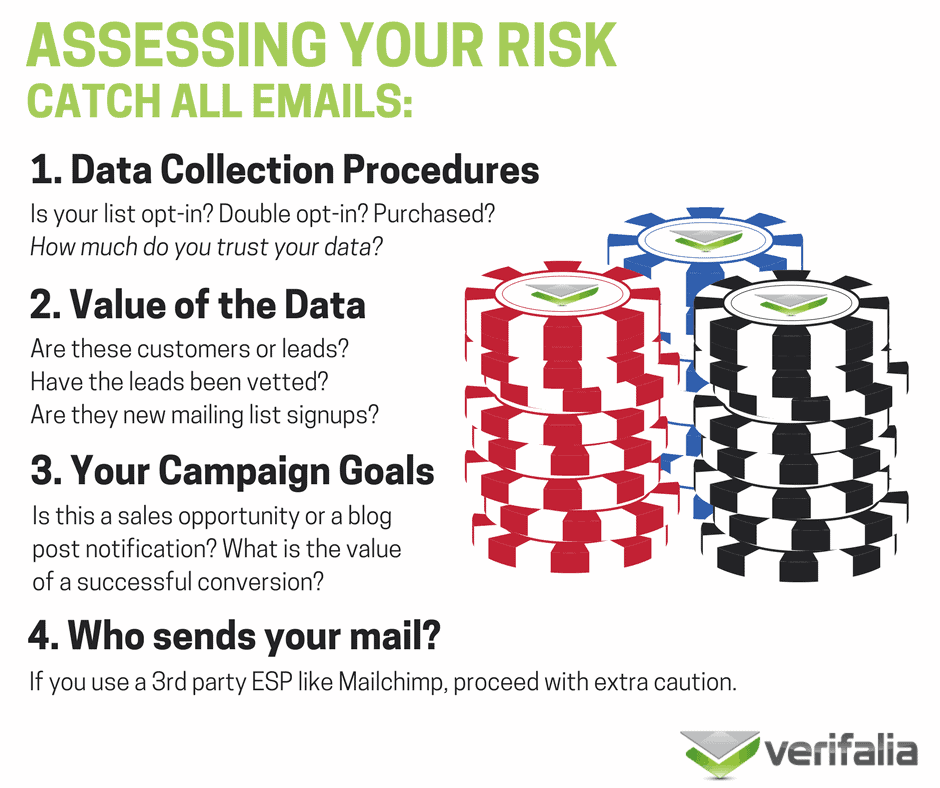The same thing happens every day here at Verifalia.
A new client is breezing through his first validation report when he suddenly hits a snag and we get this message:
What is a Catch-All email account?
Catch-all is the type of email address that causes the most confusion for our clients and handling them properly requires an understanding of what they are and how they work.
The right strategy depends on the specifics of your situation, such as your data collection practices, the goals of your campaign, and how you send your email campaigns.
But don't worry! This article will introduce you to catch-all servers and the associated risks, allowing you to make the right decisions for your business.
What is a catch-all email server?
A catch-all email server is also referred to as an “accept all” server, which should help you understand how it functions:
A catch-all is a mail server configured to accept all emails sent to the domain, regardless of whether or not the specified mailbox exists.
For instance, if the Verifalia mail server was set up as catch-all then any email address at the Verifalia.com domain would be accepted, such as abc@verifalia.com, mickey-mouse@verifalia.com or fake.email.address@verifalia.com.
Why do catch-all emails exist?
Initially, webmasters used catch-all servers to prevent emails from being lost. Erroneous addresses were redirected to a generic “catch-all” mailbox. This mailbox could be reviewed periodically to ensure that no important messages went missing.
Sounds like a great idea, right?
Well, it was a great idea...until spammers caught on.
Catch-all servers make it easier for spammers to bombard a domain with unsolicited messages. For this reason, catch-all mailboxes today tend to be overloaded with spam, which can make them functionally useless and prone to be over quota.
Can a catch-all email address be verified?
No, and that's why they are so frustrating.
No email verification service can confirm that a specific mailbox exists at a catch-all domain.
The service can confirm that the domain is active and advanced services (like Verifalia) will detect the catch-all configuration. But they can't use SMTP to peek behind the curtain and see what is going on at the mailbox level like they do with most servers.
The only way to verify that a mailbox exists is to send an actual email, which is very dangerous for your sender reputation at a bulk level.
The risks of catch-all emails
There are a few ways that catch-all servers can cause you problems:
- Increased Bounce Rate – Unpredictable bounces are the biggest risk to your sender reputation and the main reason to be extremely cautious.
- Some servers may automatically bounce (hard bounce) messages after initially accepting them.
- Catch-all mailboxes frequently go over their quotas, resulting in additional bounces.
- Unopened Messages – Catch-all email folders may not be monitored regularly and can even be configured to automatically delete messages to non-existent mailboxes. Expect a lower than average open rate.
- Email Service Providers – Most email service providers have a very low tolerance for bounces; so if you use an ESP be very cautious with catch-all emails, especially if they are from an unknown source, to avoid having your account suspended.
Assessing the risk for your campaigns
Consider these factors to assess your risk and develop a strategy for catch-all email addresses:

Designing your catch-all email strategy
Once you have assessed your data collections procedures, list value and campaign goals, use that information to develop a catch-all strategy.
Develop strategies at the campaign level, based on the nature and value of the campaign:
- If you are sending a compelling sales offer to a double opt-in list of existing customers then you probably don’t want to remove the catch-all addresses. These are very likely to be valid mailboxes, you know the customers exist and your conversion value is high.
- A list of new subscriptions to your newsletter has more risk and less potential reward, Proceed with caution according to your comfort level or test them in small batches.
- If your list was purchased or if you know that the quality of the data is questionable, you may want to avoid catch-all emails completely.
You don't have to employ an all-or-nothing scenario, though.
Rather than eliminating your catch-alls, you can work a small percentage of them into each of your campaigns. From there, watch the engagement statistics closely and transfer them into your larger lists if they interact with your content.
Bringing It All Together:
Catch-all email servers are the most difficult decision you will face when developing an email verification strategy.
But don’t be intimidated! Now you have all the information you need to take them on. Use the criteria provided to analyze your risk and develop the perfect action plan for your organization.
Ready to detect catch-all email addresses in your mailing list or in your app? At Verifalia, we detect catch-all email addresses as well as many other potentially risky items, and provide detailed reports of what we find: here is how it works.
Just sign up now and submit your email list, we will take care of the rest!
